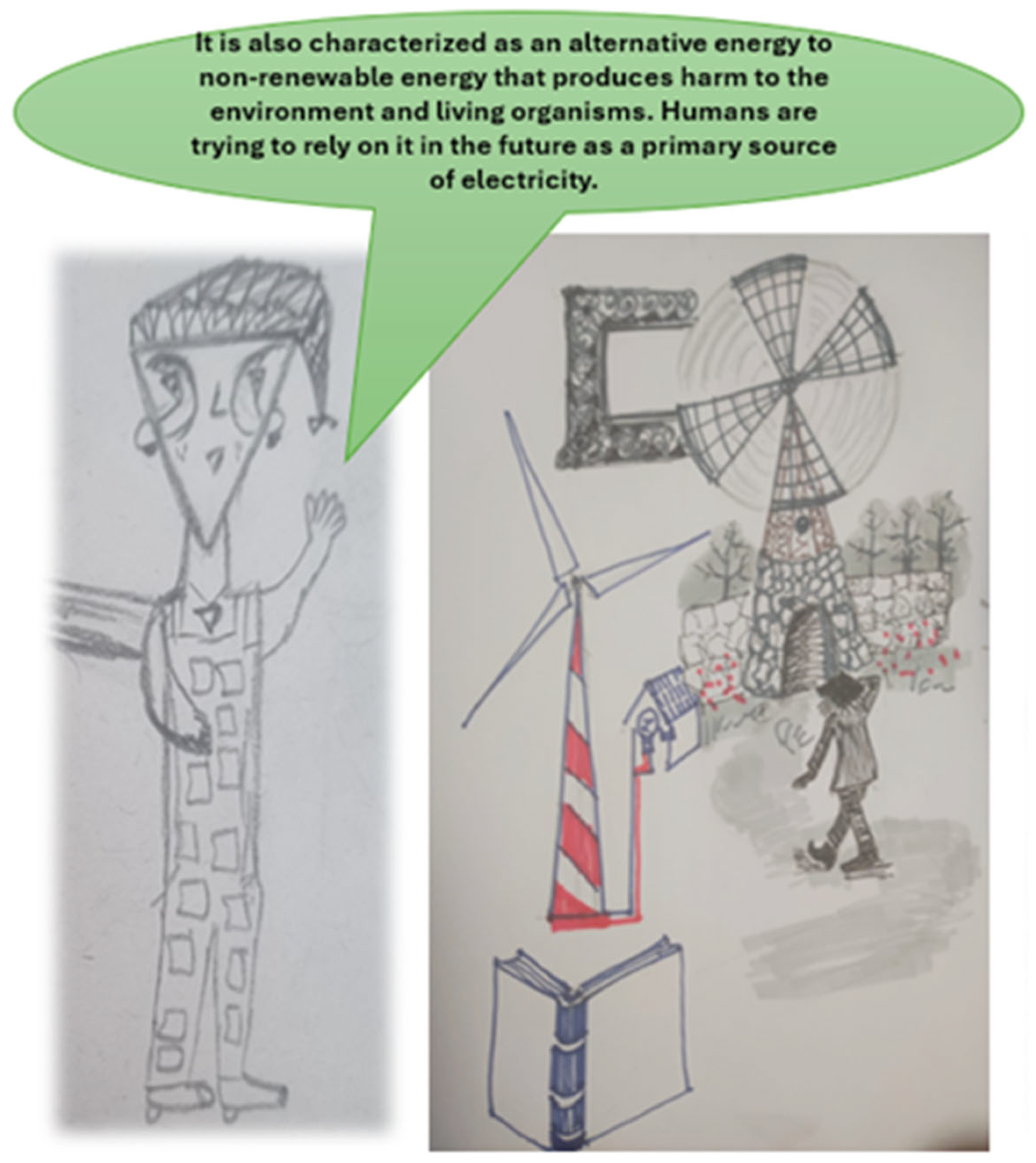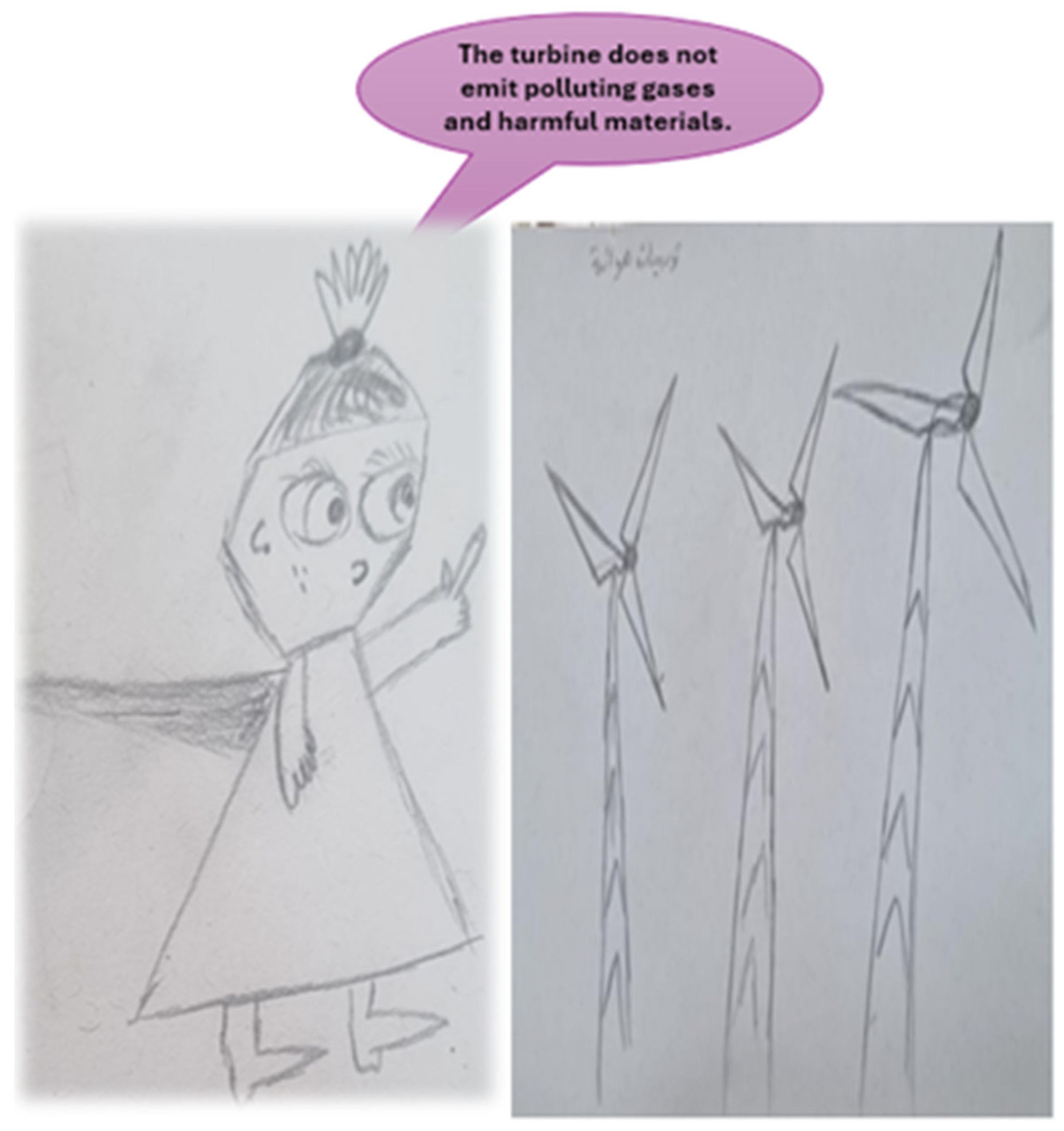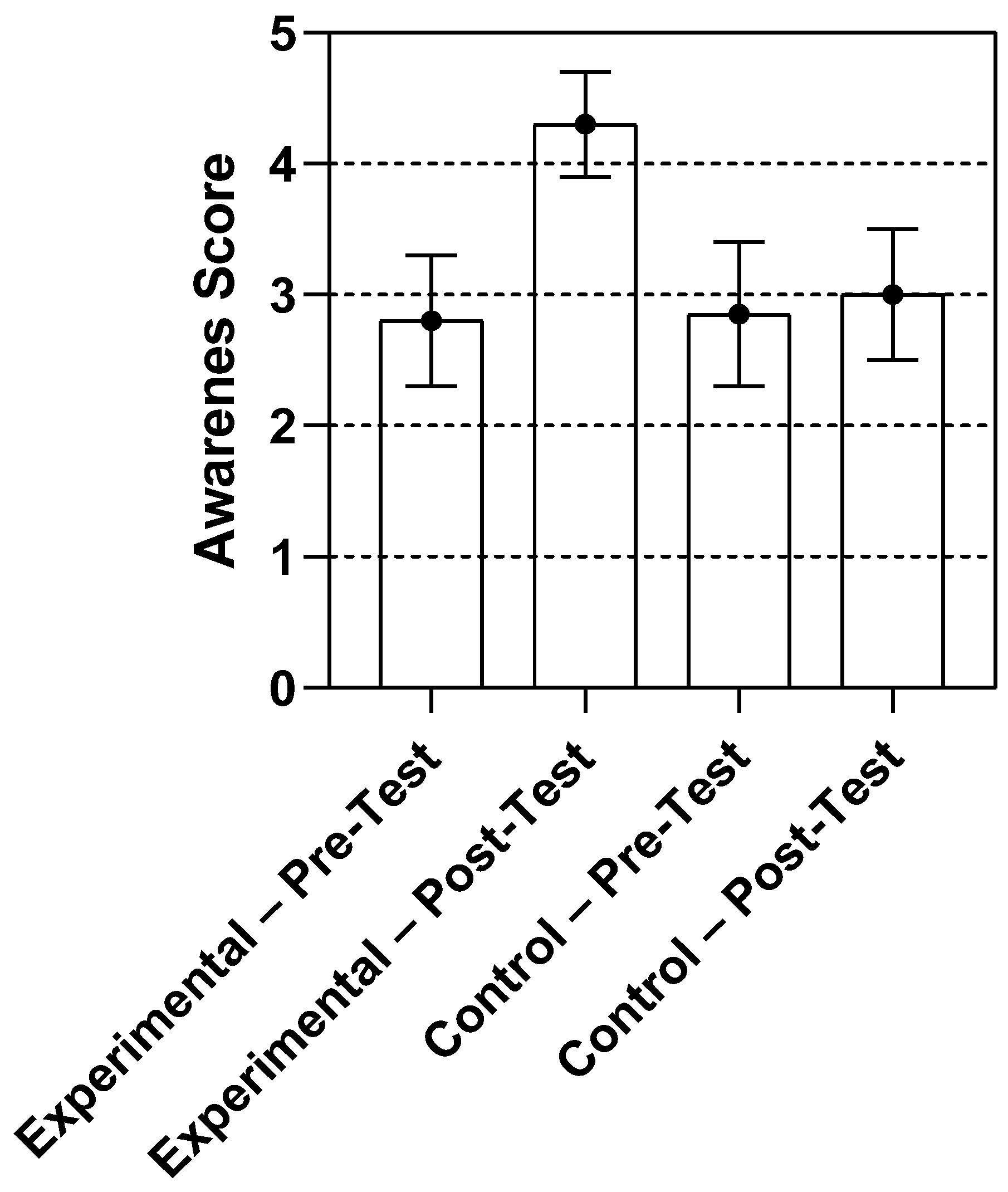Enhancing Wind Energy Awareness Among Fourth-Grade Students: The Impact of Comic-Based Learning on Environmental Education
Abstract
1. Introduction
1.1. Overview of Renewable Energy Education
1.1.1. Historical Perspective of Renewable Energy Education
1.1.2. Current Trends in Teaching Renewable Energy
1.1.3. Challenges in Renewable Energy Education
1.2. The Role of Comics in Education
1.2.1. Evolution of Educational Comics
1.2.2. Pedagogical Benefits of Using Comics
1.2.3. Case Studies on Comics in Science Education
1.2.4. Environmental Benefits of Wind Energy
1.3. Cognitive and Affective Learning Through Visual Tools
1.3.1. Theories of Visual Learning
1.3.2. Impact of Visual Tools on Student Engagement
1.3.3. Comparative Studies of Visual vs. Traditional Learning Methods
1.4. Research Question, Objective, and Hypotheses
1.4.1. Research Question
1.4.2. Research Objective
1.4.3. Hypotheses
2. Materials and Methods
2.1. Study Design
2.2. Research Population and Sample
2.3. Research Instrument
- “Engineers can create a virtual view of a wind farm before construction.” This assesses awareness of virtual simulations for planning and public acceptance.
- “In hilly areas, turbine sounds are less audible downwind.” This evaluates knowledge of how geography can reduce noise pollution from turbines.
- “Wind projects can increase property values.” This challenges the misconception that wind farms reduce property values.
- “Wind turbines kill more birds than other human activities.” This examines the impact of wind turbines on wildlife in comparison to other activities.
- “Wind farms are less efficient than nuclear plants.” This tests the understanding of the efficiency and reliability of various energy sources.
- “Israel’s wind potential exceeds its total electricity consumption.” This gauges awareness of local wind energy potential.
2.4. Research Procedure
2.5. Ethical Aspects of the Research
2.6. Data Analysis Procedure
3. Results
3.1. Descriptive Statistics
3.2. Testing the Research Hypotheses
4. Discussion
5. Conclusions
Funding
Institutional Review Board Statement
Informed Consent Statement
Data Availability Statement
Acknowledgments
Conflicts of Interest
Appendix A
| Statements | Not at All True | True to a Low Degree | Moderately True | True | Very True |
|---|---|---|---|---|---|
| 1 | 2 | 3 | 4 | 5 |
| 1 | 2 | 3 | 4 | 5 |
| 1 | 2 | 3 | 4 | 5 |
| 1 | 2 | 3 | 4 | 5 |
| 1 | 2 | 3 | 4 | 5 |
| 1 | 2 | 3 | 4 | 5 |
References
- Kara, T.; Şahin, A.D. Implications of climate change on wind energy potential. Sustainability 2023, 15, 14822. [Google Scholar] [CrossRef]
- Liarakou, G.; Konstantinidi, A.; Gavrilakis, C. Local renewable energy development: School teachers’ perceptions, attitudes and teaching intentions. Educ. Sci. 2021, 11, 589. [Google Scholar] [CrossRef]
- Hnatyuk, V.; Pshenychna, N.; Kara, S.; Kolodii, V.; Yaroshchuk, L. Education fosters environmental awareness and promotes sustainable development within a holistic framework. Multidiscip. Rev. 2024, 7, e2024spe012. [Google Scholar] [CrossRef]
- Shehzad, S.; Afzal, J.; Anwar, G. Significance of ‘renewable energy education’ in the curriculum of students. Acad. Educ. Soc. Sci. Rev. 2023, 3, 361–373. [Google Scholar] [CrossRef]
- Torres, J.F.; Petrakopoulou, F. A closer look at the environmental impact of solar and wind energy. Glob. Chall. 2022, 6, 2200016. [Google Scholar] [CrossRef]
- Edsand, H.-E.; Broich, T. The impact of environmental education on environmental and renewable energy technology awareness: Empirical evidence from Colombia. Int. J. Sci. Math. Educ. 2020, 18, 611–634. [Google Scholar] [CrossRef]
- Schoolman, E.D.; Guest, J.S.; Bush, K.F.; Bell, A.R. How interdisciplinary is sustainability research? Analyzing the structure of an emerging scientific field. Sustain. Sci. 2012, 7, 67–80. [Google Scholar] [CrossRef]
- Pruitt, S.L. The next generation science standards: The features and challenges. J. Sci. Teach. Educ. 2014, 25, 145–156. [Google Scholar] [CrossRef]
- Li, Y.; Chen, D.; Deng, X. The impact of digital educational games on student motivation: The mediating effect of learning engagement and the moderating effect of the digital environment. PLoS ONE 2024, 19, e0294350. [Google Scholar] [CrossRef]
- Holst, J. Towards coherence on sustainability in education: A systematic review of whole institution approaches. Sustain. Sci. 2023, 18, 1015–1030. [Google Scholar] [CrossRef]
- Alp, G.; Onan, B.C. Using comics for climate change in science education: Students’ solutions and aesthetic subtleties. J. Balt. Sci. Educ. 2023, 22, 215–231. [Google Scholar] [CrossRef]
- Maynard, C.; Garcia, J.; Lucietto, A.; Hutzel, W.; A Newell, B. Experiential learning in the energy based classroom. Int. J. Eng. Pedagog. iJEP 2021, 11, 4–26. [Google Scholar] [CrossRef]
- Hiğde, E. An interdisciplinary renewable energy education: Investigating the influence of STEM activities on perception, attitude, and behavior. J. Sci. Learn. 2022, 5, 373–385. [Google Scholar] [CrossRef]
- Mutanga, M.B. Students’ perspectives and experiences in project-based learning: A qualitative study. Trends High. Educ. 2024, 3, 903–911. [Google Scholar] [CrossRef]
- Zhan, Z.; Fong, P.S.; Mei, H.; Chang, X.; Liang, T.; Ma, Z. Sustainability education in massive open online courses: A content analysis approach. Sustainability 2015, 7, 2274–2300. [Google Scholar] [CrossRef]
- Gaffney, J.L.; O’Neil, J.K. Experiential learning and sustainable development. In Encyclopedia of Sustainability in Higher Education; Filho, W.L., Ed.; Springer: Berlin/Heidelberg, Germany, 2019. [Google Scholar] [CrossRef]
- Zickafoose, A.; Ilesanmi, O.; Diaz-Manrique, M.; Adeyemi, A.E.; Walumbe, B.; Strong, R.; Wingenbach, G.; Rodriguez, M.T.; Dooley, K. Barriers and challenges affecting quality education (sustainable development goal #4) in sub-Saharan Africa by 2030. Sustainability 2024, 16, 2657. [Google Scholar] [CrossRef]
- Iordache Platis, M.I.; Romanowicz, J. Integrating energy saving awareness into student engagement-based teaching and learning process. Sustainability 2020, 12, 9626. [Google Scholar] [CrossRef]
- Fantinelli, S.; Cortini, M.; Di Fiore, T.; Iervese, S.; Galanti, T. Bridging the gap between theoretical learning and practical application: A qualitative study in Italian education. Educ. Sci. 2024, 14, 198. [Google Scholar] [CrossRef]
- Sovacool, B.K. The cultural barriers to renewable energy and energy efficiency in the United States. Technol. Soc. 2009, 31, 365–373. [Google Scholar] [CrossRef]
- Lo, P.; Lyu, Y.-P.; Chen, J.C.-C.; Lu, J.-L.; Stark, A.J. Measuring the educational value of comic books from the school librarians’ perspective: A region-wide quantitative study in Taiwan. J. Libr. Inf. Sci. 2022, 54, 16–33. [Google Scholar] [CrossRef]
- Dycus, D.J. Chris Ware’s Jimmy Corrigan: Honing the Hybridity of the Graphic Novel. Doctoral Dissertation, Georgia State University, Atlanta, GA, USA, 2009. [Google Scholar] [CrossRef]
- Topkaya, Y.; Batdı, V.; Burak, D.; Özkaya, A. The effectiveness of using comics in education: A meta-analytic and meta-thematic analysis study. Ahmet Keleşoğlu Eğit. Fak. AKEF Derg. 2023, 5, 922–940. [Google Scholar] [CrossRef]
- Abrori, F.M.; Lavicza, Z.; Anđić, B. Socioscientific comics: Introducing students to societal issues using stories. Sci. Act. 2023, 61, 25–43. [Google Scholar] [CrossRef]
- Cotiangco, E.N.; Huraño, N.J.; Sodoso, E.R.; Sumagang, M.G.; Jumao-As, J.J.; Canoy, J.; Picardal, M.; Sanchez, J.M. Android-based audio-visual comics in enhancing conceptual understanding and motivation of chemistry concepts. Orbital Electron. J. Chem. 2024, 16, 125–135. [Google Scholar] [CrossRef]
- Fitria, Y.; Malik, A.; Mutiaramses, M.; Halili, S.H.; Amelia, R. Digital comic teaching materials: Their role is to enhance students’ literacy on organism-characteristic topics. Eurasia J. Math. Sci. Technol. Educ. 2023, 19, em2333. [Google Scholar] [CrossRef]
- Spiegel, A.N.; McQuillan, J.; Halpin, P.; Matuk, C.; Diamond, J. Engaging teenagers with science through comics. Res. Sci. Educ. 2013, 43, 2309–2326. [Google Scholar] [CrossRef]
- Syarah, E.S.; Yetti, E.; Fridani, L.; Yufiarti, Y.; Hapidin, H.; Pupala, B. Electronic comics in elementary school science learning for marine conservation. J. Pendidik. IPA Indones. 2019, 8, 500–511. [Google Scholar] [CrossRef]
- Gardose, C.K.C.; Castillo, A.A.; Madroñal, M.H. Comic-Polya Method Integration in physics: Enhance students’ conceptual understanding and motivation. Indones. J. Educ. Res. ijoer 2025, 6, 35–44. [Google Scholar] [CrossRef]
- Wisner, E.M. Exploring the complexities of photosynthesis through a comic strip. CourseSource 2022, 9. [Google Scholar] [CrossRef]
- Akcanca, N. An alternative teaching tool in science education: Educational comics. Int. Online J. Educ. Teach. IOJET 2020, 7, 1550–1570. [Google Scholar]
- Summerfield-Ryan, O.; Park, S. The power of wind: The global wind energy industry’s successes and failures. Ecol. Econ. 2023, 210, 107841. [Google Scholar] [CrossRef]
- Owusu, P.A.; Asumadu-Sarkodie, S. A review of renewable energy sources, sustainability issues and climate change mitigation. Cogent Eng. 2016, 3, 1167990. [Google Scholar] [CrossRef]
- Bošnjaković, M.; Hrkać, F.; Stoić, M.; Hradovi, I. Environmental impact of wind farms. Environments 2024, 11, 257. [Google Scholar] [CrossRef]
- Olabi, A.G.; Obaideen, K.; Abdelkareem, M.A.; AlMallahi, M.N.; Shehata, N.; Alami, A.H.; Mdallal, A.; Hassan, A.A.M.; Sayed, E.T. Wind energy contribution to the sustainable development goals: A case study on London Array. Sustainability 2023, 15, 4641. [Google Scholar] [CrossRef]
- Zhou, M.; Brown, D. Educational Learning Theories, 2nd ed.; University System of Georgia: Athens, GA, USA, 2015; Available online: https://oer.galileo.usg.edu/education-textbooks/1 (accessed on 17 May 2025).
- D’Esposito, M.; Postle, B.R. The cognitive neuroscience of working memory. Annu. Rev. Psychol. 2015, 66, 115–142. [Google Scholar] [CrossRef]
- Bobek, E.; Tversky, B. Creating visual explanations improves learning. Cogn. Res. Princ. Implic. 2016, 1, 27. [Google Scholar] [CrossRef]
- Chicca, J.; Chunta, K. Engaging students with visual stories: Using infographics in nursing education. Teach. Learn. Nurs. 2020, 15, 32–36. [Google Scholar] [CrossRef]
- Lytvynova, S.H.; Soroko, N.V. Interaction in an educational environment with virtual and augmented reality. Inf. Technol. Learn. Tools 2023, 98, 13–30. [Google Scholar] [CrossRef]
- Cupita, L.A.L.; Franco, L.M.P. The Use of infographics to enhance reading comprehension skills among learners. Colomb. Appl. Linguist. J. 2019, 21, 230–242. [Google Scholar] [CrossRef]
- Reen, F.J.; Jump, O.; McEvoy, G.; McSharry, B.P.; Morgan, J.; Murphy, D.; O’leary, N.; O’mahony, B.; Scallan, M.; Walsh, C.; et al. Students informed the development of virtual reality simulations for teaching and learning in the molecular sciences. J. Biol. Educ. 2024. online ahead of print. [Google Scholar] [CrossRef]
- Darling-Hammond, L.; Flook, L.; Cook-Harvey, C.; Barron, B.; Osher, D. Implications for educational practice of the science of learning and development. Appl. Dev. Sci. 2019, 24, 97–140. [Google Scholar] [CrossRef]
- Rodriguez, L.; Lin, X. The impact of comics on knowledge, attitude and behavioural intentions related to wind energy. J. Vis. Lit. 2016, 35, 237–252. [Google Scholar] [CrossRef]
- Mir, K.J.; Fatima, S.A.; Fatima, S.T. Impact of dual coding strategy to enhance students’ retention of scientific concepts in middle schools. Ann. Hum. Soc. Sci. 2023, 4, 655–666. [Google Scholar] [CrossRef]
- Efendi, R.A.; Budiarto, M.; Wibawanto, H. The effect of interactive multimedia on improving cognitive learning outcomes in senior high school students. Int. J. Educ. Knowl. Manag. 2021, 4, 1–9. [Google Scholar] [CrossRef]
- Mayer, R.E. The past, present, and future of the cognitive theory of multimedia learning. Educ. Psychol. Rev. 2024, 36, 8. [Google Scholar] [CrossRef]
- Fernando, S.Y.; Marikar, F.M. Constructivist teaching/learning theory and participatory teaching methods. J. Curric. Teach. 2017, 6, 110. [Google Scholar] [CrossRef]



| Group | Test | Mean | Standard Deviation | Range |
|---|---|---|---|---|
| Experimental | Pre-test | 2.80 | 0.50 | 2.0–3.6 |
| Post-test | 4.30 | 0.40 | 3.6–4.8 | |
| Control | Pre-test | 2.85 | 0.55 | 2.0–3.8 |
| Post-test | 3.00 | 0.50 | 2.4–3.8 |
| Source | SS | df | MS | F | p |
|---|---|---|---|---|---|
| Group | 8.64 | 1 | 8.64 | 34.56 | <0.001 |
| Time | 9.31 | 1 | 9.31 | 37.24 | <0.001 |
| Group × Time | 6.72 | 1 | 6.72 | 26.88 | <0.001 |
| Error | 29.40 | 116 | 0.25 |
| Source | SS | df | MS | F | p |
|---|---|---|---|---|---|
| Time | 9.31 | 1 | 9.31 | 37.24 | <0.001 |
| Time × Group | 6.72 | 1 | 6.72 | 26.88 | <0.001 |
| Error | 29.40 | 116 | 0.25 |
| Source | Wilks’ Lambda | F | p |
|---|---|---|---|
| Teaching Method | 0.43 | 5.21 | <0.001 |
| Statements | 0.27 | 4.78 | <0.001 |
| Interaction | 0.39 | 5.03 | <0.001 |
| Statement | Estimate | SE | T | p |
|---|---|---|---|---|
| 0.75 | 0.12 | 6.25 | <0.001 |
| 0.63 | 0.11 | 5.73 | <0.001 |
| 0.58 | 0.10 | 5.80 | <0.001 |
| 0.47 | 0.09 | 5.22 | <0.001 |
| 0.64 | 0.11 | 5.82 | <0.001 |
| 0.71 | 0.12 | 5.92 | <0.001 |
Disclaimer/Publisher’s Note: The statements, opinions and data contained in all publications are solely those of the individual author(s) and contributor(s) and not of MDPI and/or the editor(s). MDPI and/or the editor(s) disclaim responsibility for any injury to people or property resulting from any ideas, methods, instructions or products referred to in the content. |
© 2025 by the author. Licensee MDPI, Basel, Switzerland. This article is an open access article distributed under the terms and conditions of the Creative Commons Attribution (CC BY) license (https://creativecommons.org/licenses/by/4.0/).
Share and Cite
Asli, S. Enhancing Wind Energy Awareness Among Fourth-Grade Students: The Impact of Comic-Based Learning on Environmental Education. Sustainability 2025, 17, 4636. https://doi.org/10.3390/su17104636
Asli S. Enhancing Wind Energy Awareness Among Fourth-Grade Students: The Impact of Comic-Based Learning on Environmental Education. Sustainability. 2025; 17(10):4636. https://doi.org/10.3390/su17104636
Chicago/Turabian StyleAsli, Sare. 2025. "Enhancing Wind Energy Awareness Among Fourth-Grade Students: The Impact of Comic-Based Learning on Environmental Education" Sustainability 17, no. 10: 4636. https://doi.org/10.3390/su17104636
APA StyleAsli, S. (2025). Enhancing Wind Energy Awareness Among Fourth-Grade Students: The Impact of Comic-Based Learning on Environmental Education. Sustainability, 17(10), 4636. https://doi.org/10.3390/su17104636






